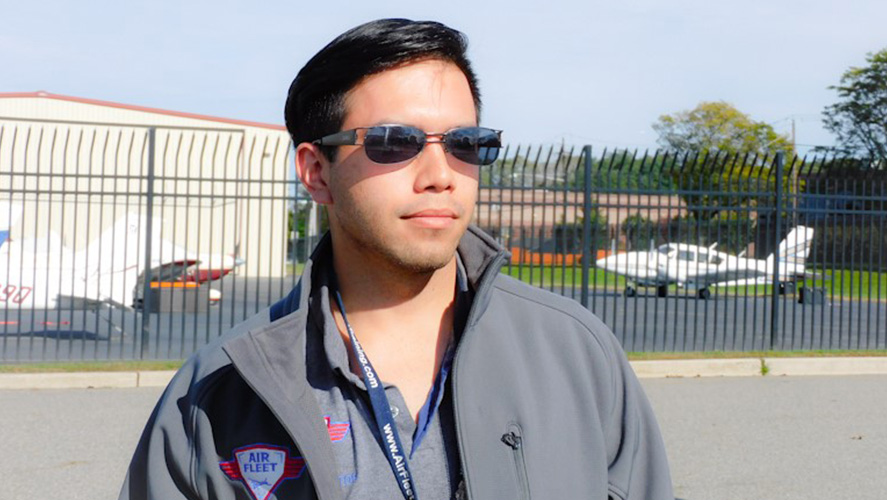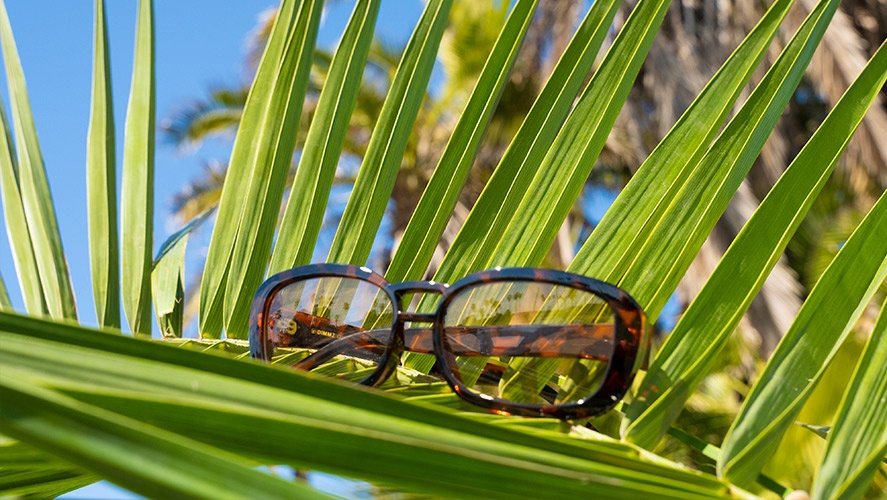
Pilots and sunglasses, like aircraft and wings, appear to go together. If you encounter a pilot, the sunglasses are always close by, whether you see them on the walk around or in cockpits, in photos or movies, at the airport, or merely on your way to work. Why, therefore, are pilots nearly never seen without sunglasses ? Is it only a fashion statement, or is there more behind it ?
What are the benefits of wearing sunglasses by a pilot ?
It is critical to maintain and defend one’s eyes, as they are the body’s light. At 35,000 feet, pilots are bathed in sunlight. At such a height, there isn’t enough air to keep the eyes safe. Less air and more intolerable brightness are downsides of higher elevations.
Sunglasses protect pilots from being blinded by the sun. They’ll need the greatest sunglasses with the least amount of distortion so they can view other planes. Flying a plane needs excellent vision. Pilots must do everything necessary to safeguard their eyesight in all circumstances since they are responsible for the lives of everyone on board.
Pilots’ careers might be jeopardized if their eyes are blurry if they can’t see well. Pilots are more prone to visual issues such as cataracts due to increased exposure at high altitudes. They’ll need sunglasses that can block out all UV rays and allow them to see clearly both inside and outside the cockpit.
They must be able to recognize air traffic, airport symbols and markings, as well as cockpit devices such as a checklist, flight engine buttons, and emergency procedures manuals, among other things. Pilots don’t wear sunglasses just to seem cool ; their eyesight is so important to them that they are willing to risk damaging their vision.
Anti-glare qualities are included in the pilot sunglasses. Glare interferes with the pilot’s ability to read the flight instruments and takes their eyesight away for a brief period. If they don’t use sunglasses, many pilots have eye discomfort. Being a pilot necessitates flying in many locations (which we all desire), yet weather conditions are not consistent at all times and in all locations. Weather changes can harm a pilot’s vision, and shifting UV radiation can cause damage. Pilots, as a result, wear sunglasses.
When purchasing pilot sunglasses, what features or characteristics should we consider ? The following are the most important things to keep in mind :
- Polarization or non-polarization of the lens
Anti-glare filters are included in the polarized sunglass because they may interact with materials in the cockpit environment. Owing to the reflection of light off the glossy surfaces coming from the windscreen or other aircraft’s wings due to visibility impairment by polarized lenses, they can reduce pilots’ response time inside and avoid’ traffic circumstances. Non-polarized lenses, on the other hand, can shield the pilot’s eyes from glare and UV rays. Polarized sunglasses do not work with cockpit display screens.
- Add some color
The brightness of the environment is reduced using tinted sunglasses. Light transmittance for neutral gray color ranges from 15% to 30%. The other hues, like as green and brown, appear to be more opulent, but they are difficult to see signs and signals through.
- Materials for lenses
Crown glasses are utilized in the lens because they are scratch-resistant, easy to produce, and heavyweight. CR-39 plastic (monomer plastic) is similar in that it has high strength, is lightweight, and is readily scratched. Similarly, polycarbonate plastic lenses are the strongest and lightest material compared to CR-39, and they have UV protection built-in. They’re paintable, but they’ll need some custom work.
- Framing
Although the choice of frame is purely a matter of taste, it can interfere with pilots’ communication headsets. It should be indestructible while yet being light and comfortable to wear. They must be capable of doing their duties.
- Places of worship
The sunglasses’ temples go all the way around the ears. There are many temples, such as bayonet, cable, skull temples, and so on, that are also known as sunglass arms. Photochromic lenses are lenses that change color depending on the amount of light they receive. For flights, they aren’t normally advised. They darken in bright light and brighten in low light. After being exposed to strong light, it takes a long time for them to revert to light.
- Complementary
The pilot sunglasses must be able to stay on the pilot’s face without falling off. They must comfortably fit around the head and not be dislodged when navigating or dealing with turbulence.
Which Sunglasses Are Worn By Pilots ?
When you think of a stereotypical pilot, you usually think of Tom Cruise or a man in a uniform, both of whom are wearing Aviator sunglasses.
Metal Aviators with grey lenses, both in the ‘teardrop’ and squared designs, are among the most popular sunglasses types among pilots.
Should Pilots Wear Sunglasses ?
Pilots should wear sunglasses that adhere to a set of widely recognized rules when flying, regardless of their design or manufacturer.
Following these rules is critical since a pair with unrecommended specs might make flying difficult or dangerous.
I’ve created a list of items to watch for from the Civil Aviation Authority and the Federal Aviation Administration :
- Avoid using polarized lenses.
- Your lenses should offer 99-100 percent UVA and UVB protection and be composed of a high-quality, reputable lens material like glass, polycarbonate, or CR-39 plastic. This is what most sunglasses have.
- Sunglasses with a moderate tint and minimum color distortion should be used. Grey is the best color to choose because it distorts the least.
- For category four lenses, the lens should not retain more than 85 percent of light. As a result, category three or lower lenses should be used in the sunglasses.
- The sunglasses should be well-fitting and comfortable – you’ll be wearing them for a long time, so they shouldn’t be too tight or too loose, or they’ll fall off.
- Your sunglasses should cover as much of your face as possible, including the sides, because the light comes at you from all sides in a cockpit, especially in the sky, where light is dispersed by clouds. Small lenses let too much light and UV rays pass through the frame’s edges and should be avoided.
- Transition or photochromic lenses should be avoided in sunglasses. Transition lenses are less effective than sunglasses with permanently tinted lenses for a variety of reasons, including the fact that they darken in reaction to UV radiation and cockpit glass shields UV rays.
- Gradient lenses, which have a darker tint at the top and a lighter tint at the bottom, are available.
- You may use whichever frame type you like, as long as it doesn’t interfere with your headset or other safety gear.
- Though it has nothing to do with the style of sunglasses a pilot should wear, they do note that you shouldn’t wear sunglasses over prescription glasses or when flying at night — which is pretty self-explanatory.
And our official website provides you with the latest high-quality sunglasses that suit every pilot you can check out here !!
Are Polarized Sunglasses Required for Pilots ?
When Omni-directional light (light waves oscillating in all directions, horizontal, horizontally, and in between) bounces off a reflecting surface, it can become polarized. This indicates that all of the light waves are synchronized and vibrate in the same direction, which is generally horizontally.
Polarized light generates a dazzling glare that may be harmful and uncomfortable ; polarized lenses filter out these powerful light beams that have synchronized. Despite the glare reduction effect, the CAA and FAA advise pilots not to wear sunglasses with polarized lenses since they can alter a pilot’s view of some objects that are critical for flying. As a result, pilots should avoid polarized sunglasses.
There are several causes for this, but they all come from the fact that polarized lenses only allow particular light wavelengths to pass through them :
- Because most airplane windscreens are already polarized, seeing them using polarized glasses at certain angles causes an oil slick-like distortion, reducing visibility significantly.
- When there is any form of solar glare reflecting off other aircraft, it is simpler to see them.
- Modern airplanes employ polarized light and LCD panels that already contain an anti-glare filter. As polarized sunglasses only allow horizontal or vertical light waves to pass through, they block the LCD light when seen from certain angles, resulting in a dark screen. If your sunglasses only permit horizontal light, polarized LCD light waves will flow through, but if you twist your head 90 degrees clockwise, the filter becomes vertical and filters the output light.
- They alter the look of clouds and diminish ground reflections, which might be beneficial in some situations.
Pilot-Friendly Sunglasses
The aviator frame style is a popular frame type associated with pilots, however, pilots can wear any frame style they like. It’s purely a question of taste. A pilot’s choice of the frame should be extremely useful. Pilots are required to use specific headsets and communication devices, as well as eyewear that can handle this equipment. Sunglasses frames should also be compatible with any required respiratory protection. Depending on the type of plane a pilot is flying, different equipment will be required. A combat pilot, for example, may require eyewear that differs from those required by a commercial aircraft pilot.
Larger lenses give more UV protection than smaller lenses, hence larger frames with larger lenses are preferable for pilots. Because visible light and UV radiation may flow through the lenses’ outer edges, bigger lenses give far more protection.
Sturdy frames are also a must. The frame of a pilot’s sunglasses must be long-lasting and sturdy. It also has to look good. Even if the jet is experiencing little turbulence, pilots need their eyewear to stay put.
Conclusion :
Pilot sunglasses have now become an essential component of the pilot’s outfit as eyewear accessories. With the best pilot sunglasses, you’ll be able to see clearly from a distance.
They give up close and intermediate vision, allowing pilots to detect other planes, plot their path clearly and avoid turbulence and other life-threatening circumstances on the flight deck while reading instruments and printed instructions. Pilots can relax and enjoy their flights by wearing the finest pilot sunglasses, which have a stylish style and provide excellent eye protection. Pilot sunglasses enhance flying safety while maintaining a fashionable appearance.
